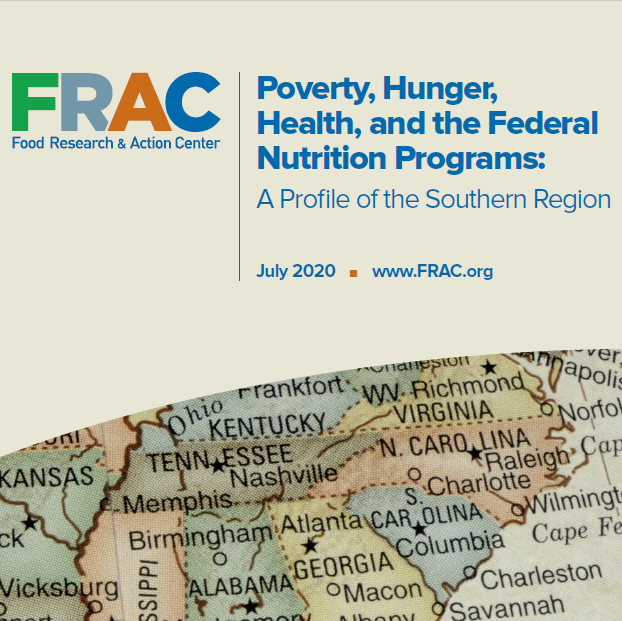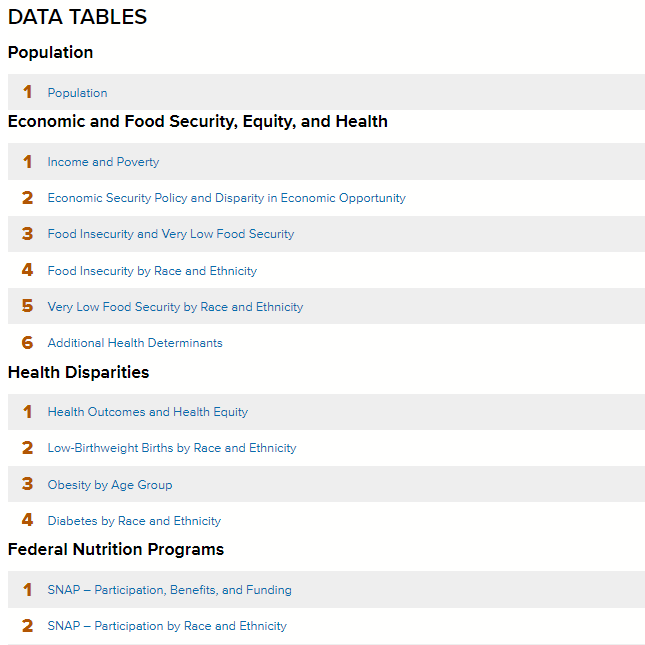The public health and economic crisis created by COVID-19 is exacerbating the already alarming rates of food insecurity, health disparities and racial inequities in the Southern Region of the U.S. FRAC’s newest report analyzes poverty rates, food insecurity levels, health disparities, racial inequities, and federal nutrition program participation in the southern states. The report finds that more must be done on the state and local level to increase participation and strengthen the federal nutrition programs in the Southern Region.
For all stakeholders, the report offers proven and effective policies and strategies that can reach and serve more of those who are eligible, including a culturally and linguistically diverse population. Recommendations in this report will allow state and local governments, policymakers, program administrators, schools, child care providers, afterschool programs, community-based and faith-based organizations, and others to connect more people to the federal nutrition programs. The federal nutrition programs covered in this report include the Supplemental Nutrition Assistance Program (SNAP); Special Supplemental Nutrition Program for Women, Infants, and Children (WIC); School Breakfast Program (SBP); National School Lunch Program (NSLP); Summer Nutrition Programs; and Child and Adult Care Food Program (CACFP).
Keep scrolling to explore key findings, highlights, and COVID-19 adjustments from FRAC’s new report: Hunger, Health, and the Federal Nutrition Programs: A Profile of the Southern Region.
Southern Poverty Report Resources
Key Findings
Economic and Food Security, Equity, and Health
-
- Policies that promote economic security in the Southern Region are limited compared to what is available in other geographic areas of the country, leading to high rates of poverty and food insecurity.
- In the Southern Region, 14.7 percent of individuals live below the federal poverty level and 12.6 percent of households experience food insecurity. These are higher rates than the rest of the U.S.
- High levels of poverty and food insecurity hurt children and families, and contribute to underperformance in health outcomes and equity, including low birthweight, obesity, diabetes, and disparity in health status based on high school education.
Federal Nutrition Programs as Valuable Resources
-
- The federal nutrition programs are a vital source of support for millions of individuals struggling to put food on the table, including nearly 10 million served through SNAP and 1.6 million served through WIC.
- Child nutrition programs feed millions of healthy meals and snacks to children in schools, child care, and summer meal programs and participation in these programs is increasing.
Participation Gaps in the Federal Nutrition Programs
-
- Despite significant growth and success in expansion efforts, the federal nutrition programs are reaching too few eligible people.
- Millions of SNAP- and WIC-eligible people in the Southern Region are missing out on the many established benefits of these programs.
- Participation in the School Breakfast Program, the Summer Nutrition Programs, and child care suppers increased but did not meet FRAC’s national participation benchmarks.
*Additional key findings are found on page 8 of the report
SNAP
The Supplemental Nutrition Assistance Program
SNAP is the nation’s first line of defense against hunger, but many SNAP-eligible people in the Southern Region are missing out on its benefits. When compared to other states and their reach with SNAP-eligible people, three Southern Region states, Arkansas (46 percent), Virginia (43 percent), and Kentucky (42 percent), ranked in the top 10 states for worst participation rates and no Southern Region states ranked in the top 10. This trend is also seen throughout the country and is impacted by several factors, including a decrease in the poverty rate before COVID-19. Louisiana experienced a 14 percent decrease in participation and became the only Southern Region state that had a less severe decrease in participation from 2013–2018, compared to the rest of the U.S. (21 percent).
Strategies to Improve SNAP Participation
- Extend Eligibility for Able-Bodied Adults Without Dependents (ABAWD)SNAP benefits for ABAWD are limited to 3 months in a 36-month period unless the individual documents sufficient hours of work or other qualifying activities. States in the Southern Region should protect unemployed and underemployed ABAWD in areas with insufficient jobs through the use of area waivers for ABAWD time limits and available discretionary exemptions.
- Raise Gross Income LimitsStates can increase SNAP gross income limits from 130 percent of the federal poverty level up to 200 percent. States should use this authority to allow more individuals struggling to put food on the table to qualify for SNAP benefits.
- Support SNAP Outreach and Application AssistanceBarriers to SNAP participation can include lack of program awareness, confusion regarding eligibility, and difficulty applying. One way to reduce these barriers is to conduct SNAP outreach and application assistance projects. Additionally, SNAP serves a linguistically diverse population and SNAP resources should be offered in multiple languages to reduce barriers to participation.
- Additional SNAP Recommendations
COVID-19 Considerations
Since the onset of COVID-19, SNAP agencies have had to adjust operations to meet increased applications for assistance and comply with social distancing protocols. All 11 Southern Region states have issued the temporary emergency SNAP allotments, and most have indicated plans to do so in the coming months while the pandemic health declaration applies. A majority of the 11 states have extended certification periods and/or waived periodic reporting requirements.
Some of the streamlining waivers and innovations could improve SNAP customer service if continued beyond the context of COVID-19.
WIC
Special Supplemental Nutrition Program for Women, Infants, and Children
Although 1.6 million people participated in WIC in 2019, the program reached only slightly less than half those eligible. Almost 2 million eligible individuals, mostly children, are not enrolled in WIC in the Southern Region. These children are missing out on the many established benefits of WIC. Expanding WIC has the potential to bring considerably more funding into the Southern Region states.
Nationally and by state, Hispanic individuals generally had the highest coverage rates. Black-Only and Other Non-Hispanic individuals had the second-highest coverage rates. White-Only Non-Hispanic individuals had the lowest coverage rates. Consistent with national patterns, WIC coverage rates are higher for Hispanic individuals than White-Only Non-Hispanic individuals in all Southern states except Kentucky, which has equal coverage rates.
Strategies to Improve WIC Participation
- Reach and Serve Rural PopulationsSix out of the 11 Southern Region states are considered rural. Reducing the time and distance that must be traveled to participate in WIC is crucial. Promoting convenient locations, promising and delivering quick services, and featuring options (such as online or mail-in nutrition education) for keeping the required in-clinic visits to a minimum are all ways to increase access to WIC in rural communities.
Arkansas, one of the most rural of the Southern Region states, aims to reduce unnecessary visits by bundling appointments for multiple participants in the family into one clinic visit.
- Improve the WIC Clinic ExperienceRecommendations include minimizing wait times, streamlining appointments, improving customer service, addressing language barriers, and eliminating unnecessary clinic visits. In addition, it is helpful to establish convenient WIC clinic hours and locations, employ satellite offices and mobile units, and offer transportation assistance.
Mississippi has been successful in increasing WIC participation through partnering with other agencies, including MOUs with Medicaid, SNAP, and Head Start. Through WIC and Head Start’s “The Easy Choice” initiative, WIC provides on-site enrollment and benefits issuance to Head Start parents at 50 Head Start centers across Mississippi.
- Enhance the WIC Shopping ExperienceProviding access to WIC electronic benefit transfer (EBT), a WIC shopping app, and agency-specific shopping guides can improve participants’ experiences when shopping for WIC-eligible foods by reducing confusion surrounding eligible foods and limiting embarrassing check-out experiences. Per federal mandate, all WIC agencies are to transition to EBT by 2020.
In Knoxville, Tennessee, the popular “Call the WIC Lady SOS” campaign invites WIC participants to call or text the local WIC agency if they have a question or complaint while shopping. WIC customers regularly text questions with pictures of the food items attached. The University of Tennessee has worked with WIC and a local grocery store to pilot online ordering for WIC.
- Additional WIC Recommendations
COVID-19 Considerations
The COVID-19 pandemic has created unprecedented barriers to WIC. When clinics across the country were shut down abruptly, WIC lost the capacity to have in-person appointments, and the WIC rules offered no alternative method of delivering services. The Families First Coronavirus Response Act expanded USDA’s authority to allow alternative methods of delivering services by granting states waivers for requirements presenting a barrier.
Preserving access to WIC during COVID-19 is crucial for the health and well-being of mothers, infants, and children who rely on WIC’s healthy food benefits and nutrition and breastfeeding support. Below are recommended strategies:
-
- Offer phone and online services
- Employ options for flexibilities in WIC food package redemption and relax minimum stocking requirements
- Use options to extend certification periods
CACFP
Child and Adult Care Food Program
In the Southern Region, average daily attendance in CACFP has increased over the past 10 years (2009-2019) to 1.1 million children in 2019. During this time, CACFP supported over 34,000 child care centers and family child care homes with almost $1 billion in federal funding. Although attendance has increased overall, attendance at family child care homes has decreased slightly (-2.4 percent) while attendance at child care centers increased to a greater extent than the rest of the U.S. (48.3 percent).
CACFP also provided meals to over 300,000 children in the Southern Region through afterschool suppers on an average weekday in 2018. This was an increase of nearly 35,000 children from the prior year, but is not enough to reach FRAC’s participation benchmarks. Increasing participation in afterschool suppers has the potential to bring in millions more in federal funding to the Southern Region.
Strategies to Improve CACFP Participation
- Collaborate to Enhance ServicesPartners can conduct CACFP outreach, promote best practices for cross-sector collaboration, share or create nutrition materials and trainings, address gaps created by State agency capacity issues, and encourage and plan state summits, workgroups, and meetings.
- Promote Eligibility and SponsorshipState agencies should extend CACFP program eligibility to all licensed and regulated family child care. When appropriate, CACFP can extend eligibility to license exempt family child care homes that meet federal, state, or local approval standards.
Many state agencies in the Southern Region have encouraged the use of community-based sponsoring organizations to sponsor child care centers that need some extra help to be able to participate successfully in CACFP. States utilizing this successful strategy include Arkansas, Florida, North Carolina, and South Carolina.
- Maximize Meals ServedEligible sites should serve suppers instead of, or in addition to, snacks. Thousands of afterschool programs located in low income communities provide food during afterschool hours through NSLP or CACFP, yet are only serving a snack, even though they are eligible to serve a supper.
Florida, Georgia, Louisiana, Mississippi, North Carolina, and South Carolina all served more NSLP snacks in October 2018 than CACFP suppers, meaning students are missing out.
COVID-19 Considerations
CACFP programs provide critical access to meals and snacks, which is especially relevant during COVID-19 where economic hardship and the closing of schools and child care create barriers to food access. While many family child care homes and child care centers have been closed in light of COVID-19, participation in CACFP at child care locations is expected to ramp up as people return to work. Throughout the COVID-19 pandemic, it remains important to make sure that child care providers offering care to essential workers have quick access to CACFP. In addition, there should be coordination with CACFP as a key resource in state and local efforts to leverage child care and Head Start funding from the CARES Act to support families and offer quality care during COVID-19.




